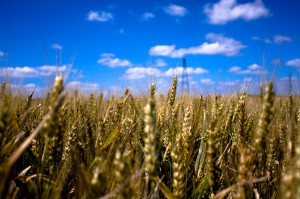26 August 2013
Why sunspots won’t help you make a fortune on wheat futures

A field of wheat. 1800s astronomer William Herschel believed sunspots affect the price of wheat. Photo by Kevin Lallier.
By Thomas Sumner
A hot topic in the climate change debate is how large a role our Sun’s temperament has played in the recent global warming trend.
A claim by 1800s astronomer William Herschel, retold for 212 years by science authors and trivia lovers, says the Sun’s moods influence things here on Earth in a more immediate way. Herschel asserted that the number of dark splotches on the Sun, called sunspots, significantly affects the wholesale price of wheat grain.
Jeffrey Love, a geophysicist for the US Geological Survey in Denver, decided to put this claim to the test, along with a handful of scientific studies published since the 1970s reporting significant correlations between sunspots and agricultural prices or crop yields. Such correlations, if they existed, would provide a useful analog for scientists researching historical solar activity.
After crunching the numbers using modern statistical analysis and all the historical data he could find, Love found their claims lacking. Love says modern climate scientists can draw lessons from Herschel’s blunder to avoid making the same mistake of seeing correlations where none exist.
“Scientists need to be skeptical while at the same time being open minded,” said Love. “When people assert something is true, we must skeptically ask whether there’s reasonable evidence to back it up.”
Love’s investigations into Herschel’s theory are reported online in an article accepted for publication in in Geophysical Research Letters, a journal of the American Geophysical Union.
Herschel’s biggest contributions to astronomy included discovering Uranus in 1781 and completing the first systematic survey of the night sky alongside his sister Caroline.
In the late 1700s Herschel turned his focus to sunspots, which we now know are the byproduct of intense magnetic activity and are about 30 percent cooler than the surrounding solar material.
Suspecting that sunspots are cold spots on the Sun, but without any way to take accurate measurements of the Sun’s temperature, Herschel looked for a way to prove their lesser temperature. He assumed the presence of sunspots would lead to fewer solar “beams” coming from the Sun, which would mean less energy reaching Earth, which he supposed would lead to cooler temperatures and smaller wheat harvests. Since weaker wheat harvests lead to higher prices, Herschel scoured historical wheat prices and compared them to sunspot activity.
“It’s a complicated chain of issues,” said Love. “Each one of those things might be real, but there are other factors involved. You need to be cautious when you have such a complicated chain of reasoning.”
According to Love, Herschel found his correlation and, in part due to his popularity and the enticing nature of the hypothesis, his work went largely unquestioned. Love’s calculations show that not only do more current data show no significant link between sunspot activity and wheat prices, but even the data Herschel used showed little evidence of a correlation.
“If you have two random datasets and you go in looking hard enough for associations, you’ll inevitably find something,” said Love.
One modern study from 1993 Love investigated showed a correlation between the 11-year sunspot cycle and everything from fish catches to sea level. Love believes the researchers cherry picked the data they used, essentially ensuring a correlation. Love’s own analysis using more inclusive data found no such link.
“The sunspot cycle might have an impact on these areas, but it is likely much too small to be noticeable,” said Love. “Ultimately for climate scientists to test a hypothesis they have to make a prediction against data they don’t have. This either means they must wait a long time, sometimes decades, to get new data, or test their hypothesis to data they purposefully didn’t use in their analysis. All the sunspot correlation papers I looked at didn’t seem to do either of those things.”
– Thomas Sumner is AGU’s science writing intern
Jeffrey J. Love (2013). On the insignifcance of Herschel’s sunspot correlation Geophysical Research Letters DOI: 10.1002/grl.50846










 GeoSpace is a blog on Earth and space science, managed by AGU’s Public Information staff. The blog features posts by AGU writers and guest contributors on all sorts of relevant science topics, but with a focus on new research and geo and space sciences-related stories that are currently in the news.
GeoSpace is a blog on Earth and space science, managed by AGU’s Public Information staff. The blog features posts by AGU writers and guest contributors on all sorts of relevant science topics, but with a focus on new research and geo and space sciences-related stories that are currently in the news.